matplotlib绘图
import matplotlib.pyplot as plt import numpy as np
plt.plot()绘制线性图
-
绘制单条线形图
-
绘制多条线形图
-
设置坐标系的比例plt.figure(figsize=(a,b))
-
设置图例legend()
-
设置轴的标识
-
图例保存
-
fig = plt.figure()
-
plt.plot(x,y)
-
figure.savefig()
-
-
曲线的样式和风格(自学)
#绘制单条线形图 x = np.array([1,2,3,4,5]) y = x + 3
plt.plot(x,y)#线性图
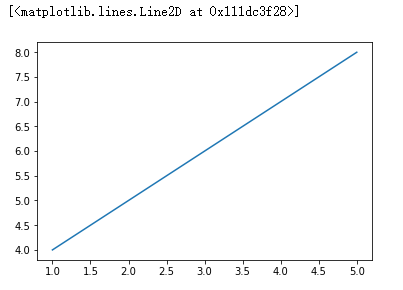
#绘制多条线形图 # 第一种方式 plt.plot(x,y) plt.plot(x+1,y-2)

# 第二种方式 plt.plot(x,y,x+1,y-2)
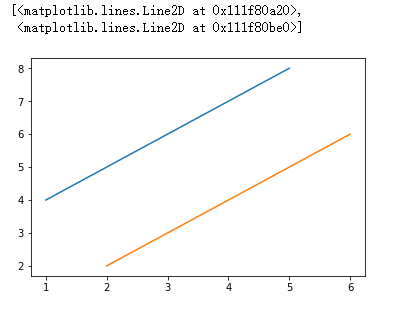
#设置坐标系的比例plt.figure(figsize=(a,b)) 将线型图等比例拉伸或缩小 plt.figure(figsize=(5,9))#放置在绘图的plot方法之前 plt.plot(x,y)
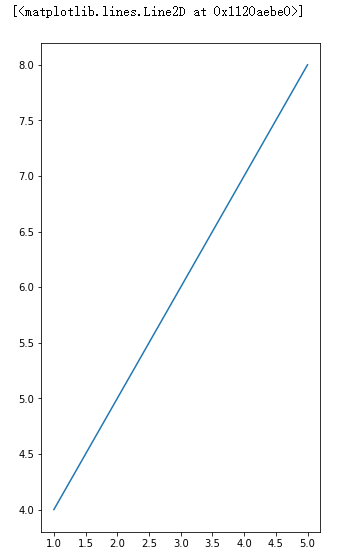
#设置图例legend() plt.plot(x,y,label='x,y') plt.plot(x+1,y-2,label='x+1,y-2') plt.legend() #图例生效
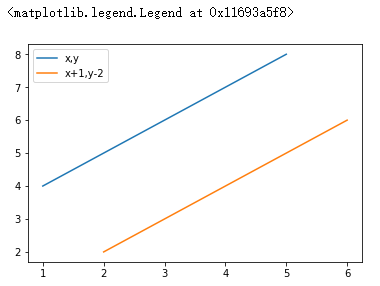
#设置轴的标识 plt.plot(x,y) plt.xlabel('temp') plt.ylabel('dist') plt.title('dist&temp')
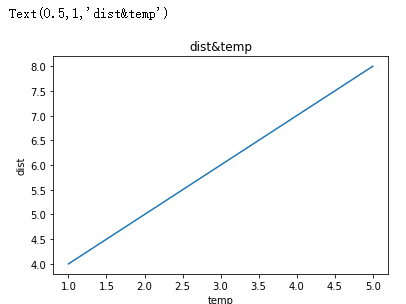
#图例保存 fig = plt.figure() #对象实例化 该对象的创建一定要放置在plot绘图之前 plt.plot(x,y,label='x,y')# 绘图 fig.savefig('./123.png')# 保存 当前目录下./
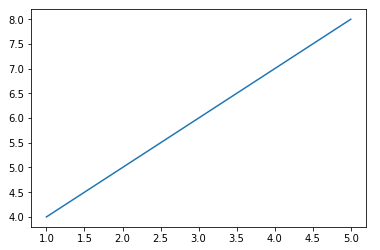
##曲线的样式和风格(自学) plt.plot(x,y,c='red',alpha=0.5)
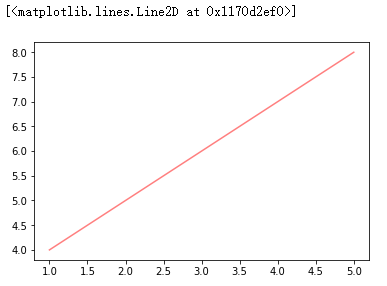
柱状图:plt.bar()
-
参数:第一个参数是索引。第二个参数是数据值。第三个参数是条形的宽度
plt.bar(x,y)
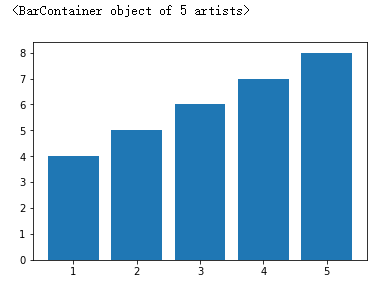
直方图
-
是一个特殊的柱状图,又叫做密度图
-
plt.hist()的参数
-
bins 可以是一个bin数量的整数值,也可以是表示bin的一个序列。默认值为10
-
normed 如果值为True,直方图的值将进行归一化处理,形成概率密度,默认值为False
-
color 指定直方图的颜色。可以是单一颜色值或颜色的序列。如果指定了多个数据集合,例如DataFrame对象,颜色序列将会设置为相同的顺序。如果未指定,将会使用一个默认的线条颜色
-
orientation 通过设置orientation为horizontal创建水平直方图。默认值为vertical
-
data = [1,1,2,2,2,3,4,5,6,6,6,6,6,6,7,8,9,0] plt.hist(data,bins=20)#bins=20 20个柱子有的柱子高为0
(array([1., 0., 2., 0., 3., 0., 1., 0., 1., 0., 0., 1., 0., 6., 0., 1., 0., 1., 0., 1.]), array([0. , 0.45, 0.9 , 1.35, 1.8 , 2.25, 2.7 , 3.15, 3.6 , 4.05, 4.5 , 4.95, 5.4 , 5.85, 6.3 , 6.75, 7.2 , 7.65, 8.1 , 8.55, 9. ]), <a list of 20 Patch objects>)
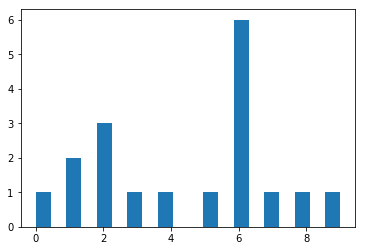
-
pie(),饼图也只有一个参数x
-
饼图适合展示各部分占总体的比例,条形图适合比较各部分的大小
arr=[11,22,31,15]
plt.pie(arr)
([<matplotlib.patches.Wedge at 0x1178be1d0>, <matplotlib.patches.Wedge at 0x1178be6a0>, <matplotlib.patches.Wedge at 0x1178beb70>, <matplotlib.patches.Wedge at 0x1178c60f0>], [Text(0.996424,0.465981,''), Text(-0.195798,1.08243,''), Text(-0.830021,-0.721848,''), Text(0.910034,-0.61793,'')])
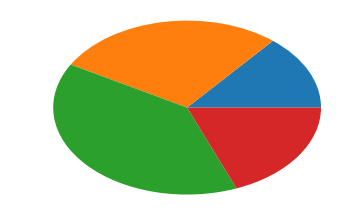
arr=[0.2,0.3,0.1]
plt.pie(arr)
([<matplotlib.patches.Wedge at 0x1177d0e80>, <matplotlib.patches.Wedge at 0x1177da390>, <matplotlib.patches.Wedge at 0x1177da8d0>], [Text(0.889919,0.646564,''), Text(-0.646564,0.889919,''), Text(-1.04616,-0.339919,'')])

arr=[11,22,31,15] plt.pie(arr,labels=['a','b','c','d'])
([<matplotlib.patches.Wedge at 0x11794aa90>, <matplotlib.patches.Wedge at 0x11794af60>, <matplotlib.patches.Wedge at 0x1179544e0>, <matplotlib.patches.Wedge at 0x117954a20>], [Text(0.996424,0.465981,'a'), Text(-0.195798,1.08243,'b'), Text(-0.830021,-0.721848,'c'), Text(0.910034,-0.61793,'d')])

arr=[11,22,31,15] plt.pie(arr,labels=['a','b','c','d'],labeldistance=0.3)
([<matplotlib.patches.Wedge at 0x1179e2278>, <matplotlib.patches.Wedge at 0x1179e2748>, <matplotlib.patches.Wedge at 0x1179e2c18>, <matplotlib.patches.Wedge at 0x1179eb198>], [Text(0.271752,0.127086,'a'), Text(-0.0533994,0.295209,'b'), Text(-0.226369,-0.196868,'c'), Text(0.248191,-0.168526,'d')])
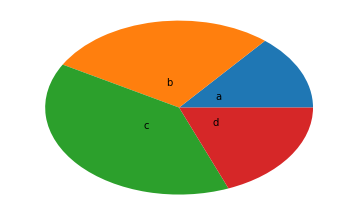
arr=[11,22,31,15] plt.pie(arr,labels=['a','b','c','d'],labeldistance=0.3,autopct='%.6f%%')
([<matplotlib.patches.Wedge at 0x117a709e8>, <matplotlib.patches.Wedge at 0x117a7a128>, <matplotlib.patches.Wedge at 0x117a7a898>, <matplotlib.patches.Wedge at 0x117a83048>], [Text(0.271752,0.127086,'a'), Text(-0.0533994,0.295209,'b'), Text(-0.226369,-0.196868,'c'), Text(0.248191,-0.168526,'d')], [Text(0.543504,0.254171,'13.924050%'), Text(-0.106799,0.590419,'27.848101%'), Text(-0.452739,-0.393735,'39.240506%'), Text(0.496382,-0.337053,'18.987341%')])

arr=[11,22,31,15] plt.pie(arr,labels=['a','b','c','d'],labeldistance=0.3,shadow=True,explode=[0.2,0.3,0.2,0.4])
([<matplotlib.patches.Wedge at 0x117ab2390>, <matplotlib.patches.Wedge at 0x117ab2b38>, <matplotlib.patches.Wedge at 0x117abb390>, <matplotlib.patches.Wedge at 0x117abbba8>], [Text(0.45292,0.21181,'a'), Text(-0.106799,0.590419,'b'), Text(-0.377282,-0.328113,'c'), Text(0.579113,-0.393228,'d')])
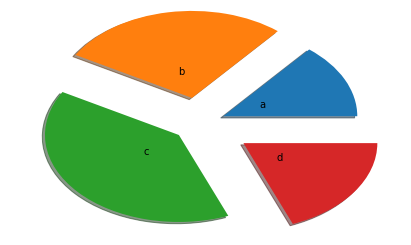
散点图scatter()
-
因变量随自变量而变化的大致趋势
x = np.array([1,3,5,7,9]) y = x ** 2 - 3 plt.scatter(x,y)
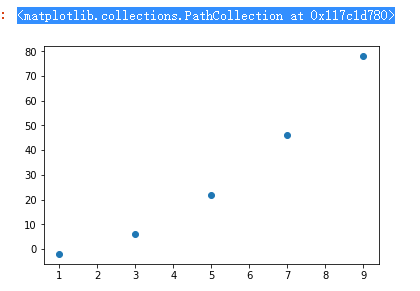
Type Markdown and LaTeX: 𝛼2α2
Type Markdown and LaTeX: 𝛼2α2
Type Markdown




 浙公网安备 33010602011771号
浙公网安备 33010602011771号